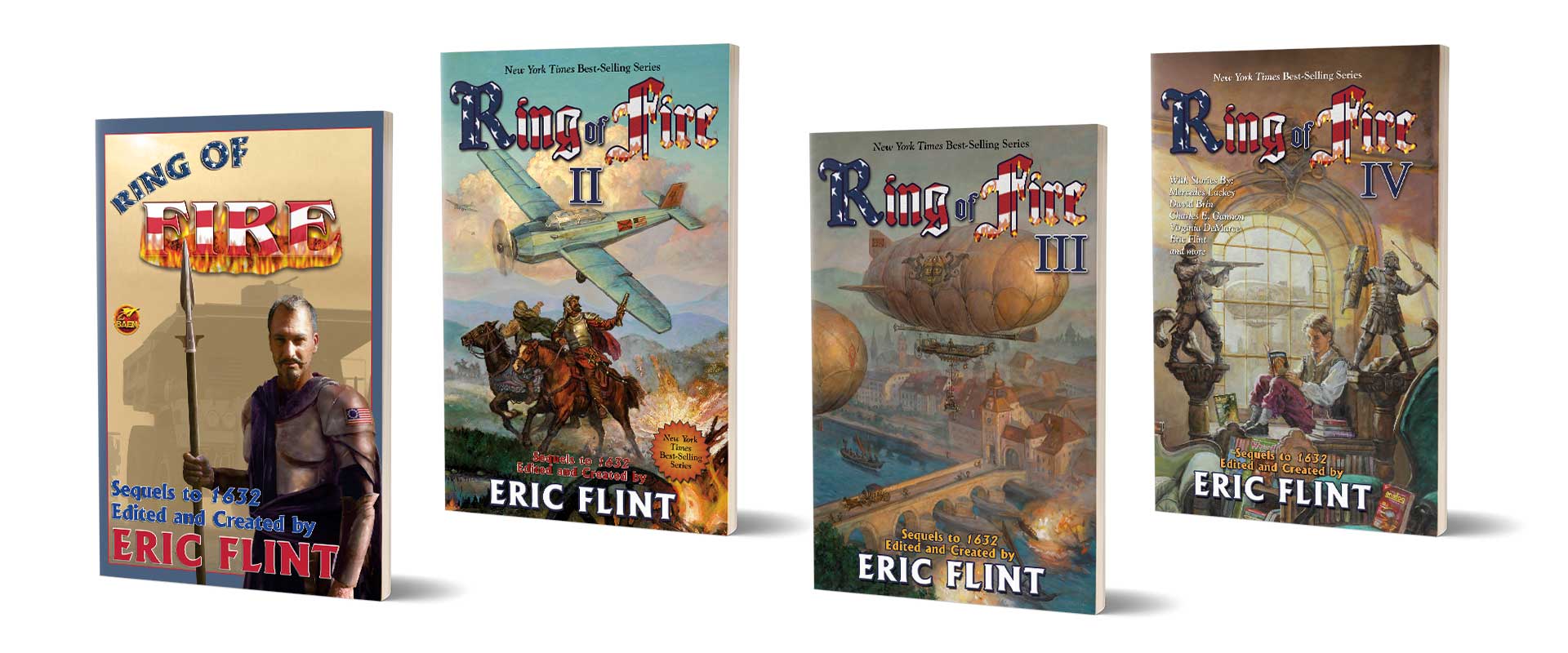One thing that makes alternate history stories so fascinating is how they answer all your “what if” questions about major historical events. They offer elaborate descriptions of what might have happened in the past and the consequences for the world we know today. Eric Flint’s 1632 (also known as the Ring of Fire) series is one of the most popular of such stories, in which the fictional American town of Grantville, West Virginia finds itself in 17th century Europe during the Thirty Years’ War.

It’s a lengthy novel series comprising at least seven mainline books and about 30 additional titles. Considering the sheer number of books and the fact that each was published with no regard whatsoever to the chronology of events being told, the 1632 series can be quite a hassle to follow even for keen readers, let alone the reluctant ones. Here, we’ll try to give you a simple reading order guide to help you keep track of the twisty plot lines.
Mainline Only
As of today, all the main events in the series are practically compiled in 8 books:
1. 1632
1.1. Ring of Fire
2. 1633
3. 1634: The Baltic War
4. 1635: The Eastern Front
5. 1636: The Saxon Uprising
6. 1636: The Ottoman Onslaught
7. 1637: The Polish Maelstrom
The first book in the series is obviously 1632, followed by a direct sequel, 1633. While you can simply read the two books back-to-back according to their natural order – like any sensible person would – it might be a good idea to insert the Ring of Fire anthology in between because the sequel to 1633 is closely tied to the anthology. The sequel in question is 1634: The Baltic War. Keep on reading until you get to the 7th book in the list above, and you’re basically a card-carrying fan of the series.
Most major military and political developments in the series are depicted in those mainline 7 novels + 1 anthology, which means reading only the mainline volumes should be good enough to keep you in the loop on any upcoming publication. When a new title comes out, you’ll be able to pick it up and read it right away without scratching your head every other page. Don’t let anybody tell you otherwise.
It’s the easy way to follow the series, but it comes with one big disadvantage: if you end up liking the stories and plan to read the other non-mainline titles, where the events are set before or between the mainline books, you’ll definitely bump into spoilers. If you’re one of those people who can’t stand spoilers, you have no choice but to travel through the more difficult path.
Comprehensive Read
Assuming you have a lot of time on your hands and will devote most of it to the series, well, then the comprehensive path is the way to go. Once you’ve reached 1634: The Baltic War (book #3 or #4 depending on how you see it) of the mainline story, take a detour and read the following volumes in this order:
| Chronological Order | Notes |
| 1634: The Ram Rebellion | Despite having the characteristics of an anthology, events in the novel are set almost concurrently with the mainline volumes. Think of it as a lower level narrative that depicts major developments observed in the mainline novels. |
| 1634: The Galileo Affair | Following the conclusion of The Baltic War, nobody including Eric Flint himself, will blame you for moving on directly to 1634: The Bavarian Crisis, simply because it’s somewhat of (but not really) a sequel. The problem is that some major developments in the novel are also discussed at length in The Galileo Affair. Let’s just say that The Galileo Affair supports the narrative of The Bavarian Crisis. |
| 1635: A Parcel of Rogues | One of only two direct sequels to The Baltic War. The other is 1635: The Eastern Front, which is not yet a mandatory read at this point. |
| Ring of Fire II | The timeframe in the three novels is not exactly sequential. Read them any order you prefer. |
| 1635: The Cannon Law | |
| 1635: The Dreeson Incident | |
| 1635: The Tangled Web | A collection of intertwining stories set at around the same time as The Dreeson Incident. A major character in both The Eastern Front and The Saxon Uprising (we haven’t reached those two yet in the “comprehensive read” list) is first introduced here. |
| 1635: The Papal Stakes | It’s the actual direct sequel to The Canon Law, but you need to get your hands on The Dreeson Incident first to get a better understanding of the storyline. If it’s not too much already, read 1635: The Wars for the Rhine. |
| 1635: The Eastern Front | They were originally intended as a single volume, but ended up being divided into two novels because of the length of the story. Read them back-to-back. |
| 1636: The Saxon Uprising | |
| Ring of Fire III | After you finally catch up with the mainline volumes again, it’s time for another anthology. Ring of Fire III lays part of the foundation for The Ottoman Onslaught (we’re not there yet, either). |
| 1636: The Kremlin Games | Don’t get hung up with the Russian storyline because it really doesn’t matter much at this point of mainline story development. Also read 1637: The Volga Rules, if you can clear your schedule for it. |
| 1636: Commander Cantrell in the West Indies | Again, the series never really missed any opportunity to branch out and further intricate the storyline. You can read these five novels in no particular order, too. In case you love e-books so much, read 1636: The Barbie Consortium, which is a direct sequel to The Viennese Waltz. |
| 1636: The Cardinal Virtues | |
| 1636: Seas of Fortune | |
| 1636: The Devil’s Opera | |
| 1636: The Viennese Waltz | |
| Ring of Fire IV | Pay specific attention to the story “Scarface.” |
| 1636: The Chronicles of Dr. Gribbleflotz | A story about the world’s greatest alchemist |
| 1636: The Ottoman Onslaught | Back to the mainline stories, at last. |
| 1637: The Polish Maelstrom | |
| 1636: Mission to the Mughals | These two don’t really have any direct connection to the main stories, but they might prepare you for upcoming volumes. |
| 1636: The China Venture | |
| 1636: The Atlantic Encounter | Similar to the previous two in terms of correlation with the mainline novels, but events in these volumes are set in the New World. |
| 1637: No Peace Beyond the Line |
We think the world that Eric Flint (and a few other authors including David Weber, Chuck Gannon, David Brin, Andrew Dennis, etc.) created in the 1632 series, with more than a few dozen books to chronicle the alternate history of Thirty Years’ War, is quite a messy one. Although the “comprehensive read” method will definitely feel more complete than the “mainline only” technique, we’d recommend the latter first; and if you decide to grow enough curiosities, embrace the former without hesitation.
Have you read any of the books in the series? What do you think is the most notable turn of events you find in the mainline volumes? We’d love to hear from you.
Other Things You Might Want to Know
Standalone novels by Eric Flint:
● Mother of Demons (1997)
● Slow Train to Arcturus (2008, co-authored with Dave Freer)
● The Gods of Sagittarius (2017, co-authored with Mike Resnick)
● The Alexander Inheritance (2017, co-authored with Gorg Huff and Paula Goodlett)
● Iron Angels (2017, co-authored with Alistair Kimble)
● Council of Fire (2019, co-authored with Walter H. Hunt)
What is the Baen Free Library?
Eric Flint and Jim Baen created the Baen Free Library in 1999 as a repository of free e-books, which can be downloaded by anyone without copy protection. It’s an ongoing experiment to determine whether the availability of those free e-books could actually boost sales of the printed versions. Authors can voluntarily provide the digital version of their published books to take part in the experiment.
Popular alternate history books:
● The Man in the High Castle by Philip K. Dick
● The Years of Rice and Salt by Kim Stanley Robinson
● Bring the Jubilee by Ward Moore
● Farthing by Jo Walton
● The Plot Against America by Philip Roth
● 11/22/63: A Novel by Stephen King
● The Underground Railroad by Colson Whitehead
● The Calculating Stars by Mary Robinette Kowal
● Climb the Wind By Pamela Sargent
● Making History by Stephen Fry
Check out other articles by month:







